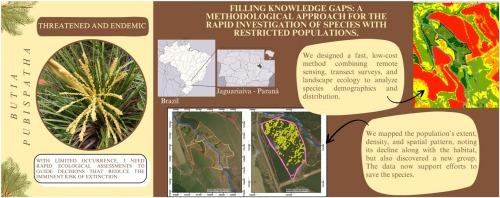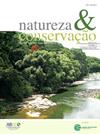填补知识空白:限制种群物种快速调查的方法学方法
IF 3.5
2区 环境科学与生态学
Q1 BIODIVERSITY CONSERVATION
引用次数: 0
摘要
许多植物物种在地理、遗传和生态数据方面仍然存在差距,特别是那些通常稀有和濒危的有限种群。这种数据的缺乏阻碍了保护工作,特别是在面临栖息地迅速退化和研究投资有限的地区。此外,技术、方法、财政和政府方面的挑战进一步阻碍了数据收集。为了解决这一问题,我们开发了多尺度生境和种群快速评估(MHPR)方法,该方法整合了广泛测试、低成本和快速应用的技术,以评估种群限制物种的分布、人口和种群下降风险。我们将这种方法应用于Butia pubispatha,这是一种巴西南部草原特有的极度濒危的矮棕榈,从一个单一的记录种群中已知。在第一阶段,我们利用Landsat卫星图像和归一化植被指数(NDVI)分析了2013 - 2021年的栖息地退化情况。利用景观生态学原理,我们确定了具有最高支持潜力的焦点生境斑块。在第二阶段,我们在该区域内进行了系统的样带和距离采样,绘制了种群图并确定了退化程度较低的区域。对人口密度最高的部门进行了普查。在第三阶段,我们利用Morisita指数和Ripley的K函数分析空间格局。我们的方法被证明是非常有效和可复制的。NDVI成功地检测到栖息地随时间的变化,显示2013年至2021年焦点栖息地斑块减少了86.7%,突显了该物种因栖息地退化而面临的严重威胁。共录得种群1615只,种群密度81.2 in/ha,分布范围145 m。在这项研究中发现了第二种人群。本研究结果为植物物候学研究、苗木生产、遗传研究以及建立保护区和转移个体保护的公共政策提供了重要的参考。本文章由计算机程序翻译,如有差异,请以英文原文为准。

Filling knowledge gaps: A methodological approach for the rapid investigation of species with restricted populations
Gaps in geographic, genetic, and ecological data persist for many plant species, particularly those with restricted populations that are often rare and endangered. This lack of data hampers conservation efforts, especially in regions facing rapid habitat degradation and limited research investment. Additionally, technological, methodological, financial, and governmental challenges further hinder data collection. To address this issue, we developed the Multi-Scale Habitat and Population Rapid Assessment (MHPR) methodology, integrating widely tested, low-cost, and rapid-application technologies to assess distribution, demography, and population decline risks in species with restricted populations. We applied this approach to Butia pubispatha, a critically endangered dwarf palm endemic to the southern Brazilian grasslands, known from a single recorded population. In the first phase, we used Landsat satellite imagery and the Normalized Difference Vegetation Index (NDVI) to analyze habitat degradation between 2013 and 2021. Using landscape ecology principles, we identified the focal habitat patch with the highest potential to support the species. In the second phase, we conducted systematic transects and distance sampling within this area, mapping the population and identifying less degraded sectors. The highest-density sector was censused. In the third phase, we analyzed spatial patterns using Morisita’s Index and Ripley’s K function. Our method proved highly effective and replicable. NDVI successfully detected habitat changes over time, revealing an 86.7% reduction in the focal habitat patch from 2013 to 2021, underscoring the species’ critical threat due to habitat degradation. We recorded 1,615 individuals, with an estimated density of 81.2 in/ha and a dispersal range of 145 m. A second population was identified in this study. Our findings provide key insights for phenological studies, seedling production, genetic research, and public policies aimed at establishing protected areas and translocating individuals for the conservation of Butia pubispatha.
求助全文
通过发布文献求助,成功后即可免费获取论文全文。
去求助
来源期刊

Perspectives in Ecology and Conservation
Environmental Science-Nature and Landscape Conservation
CiteScore
7.80
自引率
4.30%
发文量
46
审稿时长
59 days
期刊介绍:
Perspectives in Ecology and Conservation (PECON) is a scientific journal devoted to improving theoretical and conceptual aspects of conservation science. It has the main purpose of communicating new research and advances to different actors of society, including researchers, conservationists, practitioners, and policymakers. Perspectives in Ecology and Conservation publishes original papers on biodiversity conservation and restoration, on the main drivers affecting native ecosystems, and on nature’s benefits to people and human wellbeing. This scope includes studies on biodiversity patterns, the effects of habitat loss, fragmentation, biological invasion and climate change on biodiversity, conservation genetics, spatial conservation planning, ecosystem management, ecosystem services, sustainability and resilience of socio-ecological systems, conservation policy, among others.
 求助内容:
求助内容: 应助结果提醒方式:
应助结果提醒方式:


